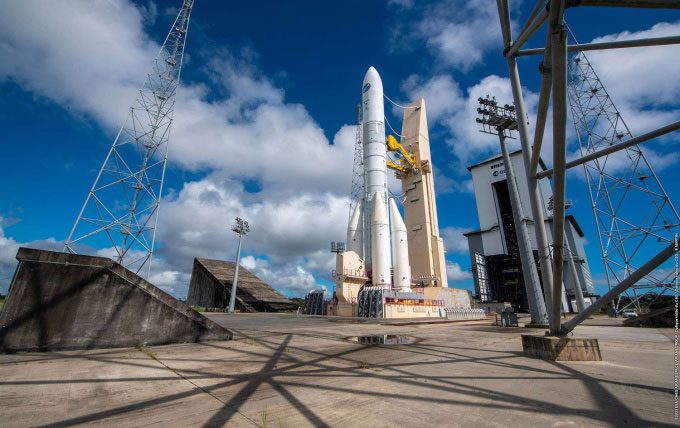Several new rockets from Europe and the United States are set to launch next year, as the aerospace industry faces a shortage of launch vehicles due to the increasing number of satellites.
Ariane 6
The Ariane 6 rocket, developed by ArianeGroup, a French company, for the European Space Agency (ESA), is scheduled for its first flight between June 15 and July 31, 2024, after a four-year delay caused by COVID-19 and other challenges. The project was initiated in 2014 as a European response to the rapid development of the Falcon 9, a rocket produced by the American company SpaceX. Based on the Ariane 5, the Ariane 6 is expected to be half the cost of its predecessor due to new manufacturing methods.

Ariane 6 rocket at the European Spaceport launch site in Kourou, Guyana, France, on June 22. (Photo: AFP).
Currently, Ariane 6 has plans for 28 launches. This rocket comes in two versions, with the more powerful version capable of carrying 11.5 tons of cargo to geostationary orbit and 21.6 tons to low Earth orbit. Once Ariane 6 becomes operational, the challenge for ArianeGroup will be to increase production. “Scaling from 2 rockets to 9 rockets per year is a significant industrial challenge,” said CEO Martin Sion.
Vega C
Grounded since December 2022 following the failure of its first commercial flight, the Vega C rocket, produced by the Italian aerospace company Avio, is expected to launch again in the fourth quarter of next year. The incident was caused by a malfunctioning rocket engine nozzle, requiring redesign efforts. The Vega C stands approximately 35 meters tall with a launch mass of 210 tons.
The lack of small rockets has compelled ESA to rely on American SpaceX to launch some European scientific satellites and GPS satellites. A successful launch of Vega C would help alleviate this issue.
Vulcan Centaur
The United Launch Alliance (ULA), a joint venture between Boeing and Lockheed Martin in the U.S., is developing the Vulcan Centaur rocket to replace the aging Atlas V and Delta IV launch vehicles. After completing its initial flights, ULA plans to begin recovering and reusing the first stage of the rocket. This reusability, along with other improvements, makes Vulcan Centaur significantly more affordable compared to its predecessors, according to ULA CEO Tory Bruno.
The Vulcan Centaur can carry 27.2 tons of cargo to low Earth orbit, comparable to the Falcon 9 rocket. The first launch of Vulcan Centaur is anticipated in early January 2024. In this mission, a private lunar lander could become the first U.S. spacecraft to land on the Moon since the Apollo program ended. In the second mission, the rocket will launch Sierra Space’s new Dream Chaser spacecraft into space in the second quarter of 2024. This mini space shuttle will be responsible for resupply missions to the International Space Station (ISS).
Starship
SpaceX will continue testing its massive Starship launch system in 2024. The first two flights after the complete assembly of this rocket system ended in explosions. SpaceX stated that the explosions during the early development stages of the rocket were welcomed as they contributed to faster design decisions. In the second flight in November 2023, the two stages of the rocket successfully separated before exploding, causing no significant damage to the launch pad.
The Starship launch system exploded during its second test flight in November 2023. (Video: WSJ).
Starship is the largest and most powerful launch vehicle ever built, standing approximately 121 meters tall. NASA is closely monitoring the development of Starship. The agency has contracted to use a version of Starship as a lunar lander for its Artemis missions.
SpaceX founder Elon Musk predicts that Starship could launch again in a few weeks. However, the next launch will not occur until the Federal Aviation Administration (FAA) approves it.
New Glenn
Blue Origin, the company founded by billionaire Jeff Bezos, has taken tourists to the edge of space on short suborbital flights using the New Shepard rocket. However, the company is also developing a larger rocket, New Glenn, which stands 98 meters tall and can carry 45 tons of cargo to low Earth orbit. This capacity is more than double that of the Falcon 9, yet still smaller than SpaceX’s Falcon Heavy, which can carry 63.8 tons.
“We plan to launch in 2024,” a spokesperson from Blue Origin said regarding New Glenn. One of the rocket’s early flights will assist NASA’s EscaPADE mission in studying Martian atmospheres. New Glenn is also part of the lunar lander system that NASA has ordered for its Artemis 5 mission.



















































